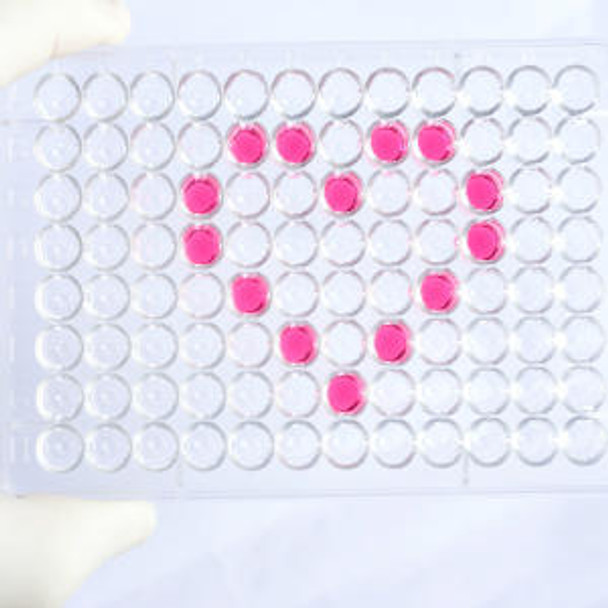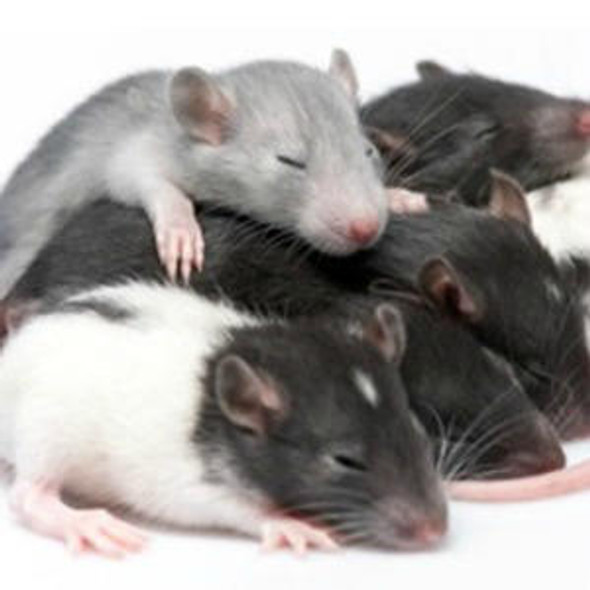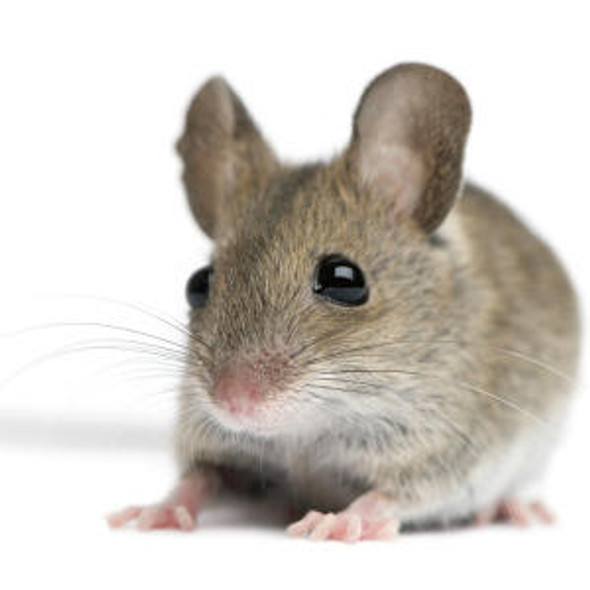Human Gremlin-1 (GREM1) ELISA Kit (HUEB2197)
- SKU:
- HUEB2197
- Product Type:
- ELISA Kit
- Size:
- 96 Assays
- Uniprot:
- O60565
- Range:
- 125-8000 pg/mL
- ELISA Type:
- Sandwich
- Synonyms:
- GREM1, GremLin 1, DAND2
- Reactivity:
- Human
Description
Human Gremlin-1 (GREM1) ELISA Kit
The Human Gremlin-1 (GREM1) ELISA Kit is a highly reliable and sensitive tool for the accurate detection of GREM1 levels in human serum, plasma, and cell culture supernatants. This kit offers high specificity and precision, ensuring consistent and reproducible results for a variety of research applications.GREM1 is a critical protein involved in regulating cell growth and development, particularly in embryonic development and organogenesis. Abnormal GREM1 expression has been implicated in various diseases such as cancer, fibrosis, and inflammatory conditions, making it a valuable biomarker for studying these diseases and potentially identifying new therapeutic targets.
Overall, the Human GREM1 ELISA Kit is essential for researchers looking to explore the role of GREM1 in health and disease, offering a valuable tool for advancing scientific understanding and potentially improving clinical outcomes.
| Product Name: | Human Gremlin-1 (GREM1) ELISA Kit |
| SKU: | HUEB2197 |
| Size: | 96T |
| Target: | Human Gremlin-1 (GREM1) |
| Synonyms: | Cell proliferation-inducing gene 2 protein, Cysteine knot superfamily 1, BMP antagonist 1, DAN domain family member 2, Down-regulated in Mos-transformed cells protein, Increased in high glucose protein 2, IHG-2, PIG2, CKTSF1B1, DAND2, DRM |
| Assay Type: | Sandwich |
| Detection Method: | ELISA |
| Reactivity: | Human |
| Detection Range: | 125-8000pg/mL |
| Sensitivity: | 32pg/mL |
| Intra CV: | 5.1% | ||||||||||||||||||||
| Inter CV: | 10.1% | ||||||||||||||||||||
| Linearity: |
| ||||||||||||||||||||
| Recovery: |
| ||||||||||||||||||||
| Function: | Cytokine that may play an important role during carcinogenesis and metanephric kidney organogenesis, as a BMP antagonist required for early limb outgrowth and patterning in maintaining the FGF4-SHH feedback loop. Down-regulates the BMP4 signaling in a dose-dependent manner. Acts as inhibitor of monocyte chemotaxis. |
| Uniprot: | O60565 |
| Sample Type: | Serum, plasma, tissue homogenates, cell culture supernates and other biological fluids |
| Specificity: | Natural and recombinant human Gremlin-1 |
| Sub Unit: | Interacts with SLIT1 and SLIT2 in a glycosylation-dependent manner. |
| Subcellular Location: | Secreted |
| Storage: | Please see kit components below for exact storage details |
| Note: | For research use only |
| UniProt Protein Function: | GREM1: Cytokine that may play an important role during carcinogenesis and metanephric kidney organogenesis, as a BMP antagonist required for early limb outgrowth and patterning in maintaining the FGF4-SHH feedback loop. Down-regulates the BMP4 signaling in a dose-dependent manner. Acts as inhibitor of monocyte chemotaxis. Interacts with SLIT1 and SLIT2 in a glycosylation- dependent manner. By high glucose through TGFB1-mediated pathways in mesangial cell. Down-regulated in tumor cell lines. Highly expressed in small intestine, fetal brain and colon. Weakly expressed in brain, ovary, prostate, pancreas and skeletal muscle. In brain found in the region localized around the internal capsule in the large subcortical nuclei, including caudate, putamen, substantia nigra, thalamus and subthalamus. Predominantly expressed in normal cells including neurons, astrocytes and fibroblasts. Belongs to the DAN family. 2 isoforms of the human protein are produced by alternative splicing. |
| UniProt Protein Details: | Protein type:Secreted, signal peptide; Secreted Chromosomal Location of Human Ortholog: 15q13.3 Molecular Function:morphogen activity; protein binding; receptor agonist activity; transmembrane receptor protein tyrosine kinase activator activity; vascular endothelial growth factor receptor 2 binding Biological Process: cell migration during sprouting angiogenesis; cell morphogenesis; collagen fibril organization; determination of dorsal identity; limb development; negative regulation of apoptosis; negative regulation of BMP signaling pathway; negative regulation of bone mineralization; negative regulation of bone remodeling; negative regulation of chondrocyte differentiation; negative regulation of osteoblast proliferation; positive regulation of cell proliferation; positive regulation of receptor internalization; positive regulation of telomerase activity; positive regulation of transcription from RNA polymerase II promoter; regulation of stress-activated MAPK cascade; signal transduction |
| NCBI Summary: | This gene encodes a member of the BMP (bone morphogenic protein) antagonist family. Like BMPs, BMP antagonists contain cystine knots and typically form homo- and heterodimers. The CAN (cerberus and dan) subfamily of BMP antagonists, to which this gene belongs, is characterized by a C-terminal cystine knot with an eight-membered ring. The antagonistic effect of the secreted glycosylated protein encoded by this gene is likely due to its direct binding to BMP proteins. As an antagonist of BMP, this gene may play a role in regulating organogenesis, body patterning, and tissue differentiation. In mouse, this protein has been shown to relay the sonic hedgehog (SHH) signal from the polarizing region to the apical ectodermal ridge during limb bud outgrowth. Alternatively spliced transcript variants encoding different isoforms have been found for this gene. [provided by RefSeq, Jul 2010] |
| UniProt Code: | O60565 |
| NCBI GenInfo Identifier: | 62510668 |
| NCBI Gene ID: | 26585 |
| NCBI Accession: | O60565.1 |
| UniProt Secondary Accession: | O60565,Q52LV3, Q8N914, Q8N936, |
| UniProt Related Accession: | O60565 |
| Molecular Weight: | |
| NCBI Full Name: | Gremlin-1 |
| NCBI Synonym Full Names: | gremlin 1, DAN family BMP antagonist |
| NCBI Official Symbol: | GREM1 |
| NCBI Official Synonym Symbols: | DRM; HMPS; MPSH; PIG2; CRAC1; CRCS4; DAND2; HMPS1; IHG-2; DUP15q; C15DUPq; GREMLIN; CKTSF1B1 |
| NCBI Protein Information: | gremlin-1 |
| UniProt Protein Name: | Gremlin-1 |
| UniProt Synonym Protein Names: | Cell proliferation-inducing gene 2 protein; Cysteine knot superfamily 1, BMP antagonist 1; DAN domain family member 2; Down-regulated in Mos-transformed cells protein; Increased in high glucose protein 2; IHG-2 |
| Protein Family: | Gremlin |
| UniProt Gene Name: | GREM1 |
| UniProt Entry Name: | GREM1_HUMAN |
| Component | Quantity (96 Assays) | Storage |
| ELISA Microplate (Dismountable) | 8×12 strips | -20°C |
| Lyophilized Standard | 2 | -20°C |
| Sample Diluent | 20ml | -20°C |
| Assay Diluent A | 10mL | -20°C |
| Assay Diluent B | 10mL | -20°C |
| Detection Reagent A | 120µL | -20°C |
| Detection Reagent B | 120µL | -20°C |
| Wash Buffer | 30mL | 4°C |
| Substrate | 10mL | 4°C |
| Stop Solution | 10mL | 4°C |
| Plate Sealer | 5 | - |
Other materials and equipment required:
- Microplate reader with 450 nm wavelength filter
- Multichannel Pipette, Pipette, microcentrifuge tubes and disposable pipette tips
- Incubator
- Deionized or distilled water
- Absorbent paper
- Buffer resevoir
*Note: The below protocol is a sample protocol. Protocols are specific to each batch/lot. For the correct instructions please follow the protocol included in your kit.
Allow all reagents to reach room temperature (Please do not dissolve the reagents at 37°C directly). All the reagents should be mixed thoroughly by gently swirling before pipetting. Avoid foaming. Keep appropriate numbers of strips for 1 experiment and remove extra strips from microtiter plate. Removed strips should be resealed and stored at -20°C until the kits expiry date. Prepare all reagents, working standards and samples as directed in the previous sections. Please predict the concentration before assaying. If values for these are not within the range of the standard curve, users must determine the optimal sample dilutions for their experiments. We recommend running all samples in duplicate.
| Step | |
| 1. | Add Sample: Add 100µL of Standard, Blank, or Sample per well. The blank well is added with Sample diluent. Solutions are added to the bottom of micro ELISA plate well, avoid inside wall touching and foaming as possible. Mix it gently. Cover the plate with sealer we provided. Incubate for 120 minutes at 37°C. |
| 2. | Remove the liquid from each well, don't wash. Add 100µL of Detection Reagent A working solution to each well. Cover with the Plate sealer. Gently tap the plate to ensure thorough mixing. Incubate for 1 hour at 37°C. Note: if Detection Reagent A appears cloudy warm to room temperature until solution is uniform. |
| 3. | Aspirate each well and wash, repeating the process three times. Wash by filling each well with Wash Buffer (approximately 400µL) (a squirt bottle, multi-channel pipette,manifold dispenser or automated washer are needed). Complete removal of liquid at each step is essential. After the last wash, completely remove remaining Wash Buffer by aspirating or decanting. Invert the plate and pat it against thick clean absorbent paper. |
| 4. | Add 100µL of Detection Reagent B working solution to each well. Cover with the Plate sealer. Incubate for 60 minutes at 37°C. |
| 5. | Repeat the wash process for five times as conducted in step 3. |
| 6. | Add 90µL of Substrate Solution to each well. Cover with a new Plate sealer and incubate for 10-20 minutes at 37°C. Protect the plate from light. The reaction time can be shortened or extended according to the actual color change, but this should not exceed more than 30 minutes. When apparent gradient appears in standard wells, user should terminatethe reaction. |
| 7. | Add 50µL of Stop Solution to each well. If color change does not appear uniform, gently tap the plate to ensure thorough mixing. |
| 8. | Determine the optical density (OD value) of each well at once, using a micro-plate reader set to 450 nm. User should open the micro-plate reader in advance, preheat the instrument, and set the testing parameters. |
| 9. | After experiment, store all reagents according to the specified storage temperature respectively until their expiry. |
When carrying out an ELISA assay it is important to prepare your samples in order to achieve the best possible results. Below we have a list of procedures for the preparation of samples for different sample types.
| Sample Type | Protocol |
| Serum | If using serum separator tubes, allow samples to clot for 30 minutes at room temperature. Centrifuge for 10 minutes at 1,000x g. Collect the serum fraction and assay promptly or aliquot and store the samples at -80°C. Avoid multiple freeze-thaw cycles. If serum separator tubes are not being used, allow samples to clot overnight at 2-8°C. Centrifuge for 10 minutes at 1,000x g. Remove serum and assay promptly or aliquot and store the samples at -80°C. Avoid multiple freeze-thaw cycles. |
| Plasma | Collect plasma using EDTA or heparin as an anticoagulant. Centrifuge samples at 4°C for 15 mins at 1000 × g within 30 mins of collection. Collect the plasma fraction and assay promptly or aliquot and store the samples at -80°C. Avoid multiple freeze-thaw cycles. Note: Over haemolysed samples are not suitable for use with this kit. |
| Urine & Cerebrospinal Fluid | Collect the urine (mid-stream) in a sterile container, centrifuge for 20 mins at 2000-3000 rpm. Remove supernatant and assay immediately. If any precipitation is detected, repeat the centrifugation step. A similar protocol can be used for cerebrospinal fluid. |
| Cell culture supernatant | Collect the cell culture media by pipette, followed by centrifugation at 4°C for 20 mins at 1500 rpm. Collect the clear supernatant and assay immediately. |
| Cell lysates | Solubilize cells in lysis buffer and allow to sit on ice for 30 minutes. Centrifuge tubes at 14,000 x g for 5 minutes to remove insoluble material. Aliquot the supernatant into a new tube and discard the remaining whole cell extract. Quantify total protein concentration using a total protein assay. Assay immediately or aliquot and store at ≤ -20 °C. |
| Tissue homogenates | The preparation of tissue homogenates will vary depending upon tissue type. Rinse tissue with 1X PBS to remove excess blood & homogenize in 20ml of 1X PBS (including protease inhibitors) and store overnight at ≤ -20°C. Two freeze-thaw cycles are required to break the cell membranes. To further disrupt the cell membranes you can sonicate the samples. Centrifuge homogenates for 5 mins at 5000xg. Remove the supernatant and assay immediately or aliquot and store at -20°C or -80°C. |
| Tissue lysates | Rinse tissue with PBS, cut into 1-2 mm pieces, and homogenize with a tissue homogenizer in PBS. Add an equal volume of RIPA buffer containing protease inhibitors and lyse tissues at room temperature for 30 minutes with gentle agitation. Centrifuge to remove debris. Quantify total protein concentration using a total protein assay. Assay immediately or aliquot and store at ≤ -20 °C. |
| Breast Milk | Collect milk samples and centrifuge at 10,000 x g for 60 min at 4°C. Aliquot the supernatant and assay. For long term use, store samples at -80°C. Minimize freeze/thaw cycles. |







